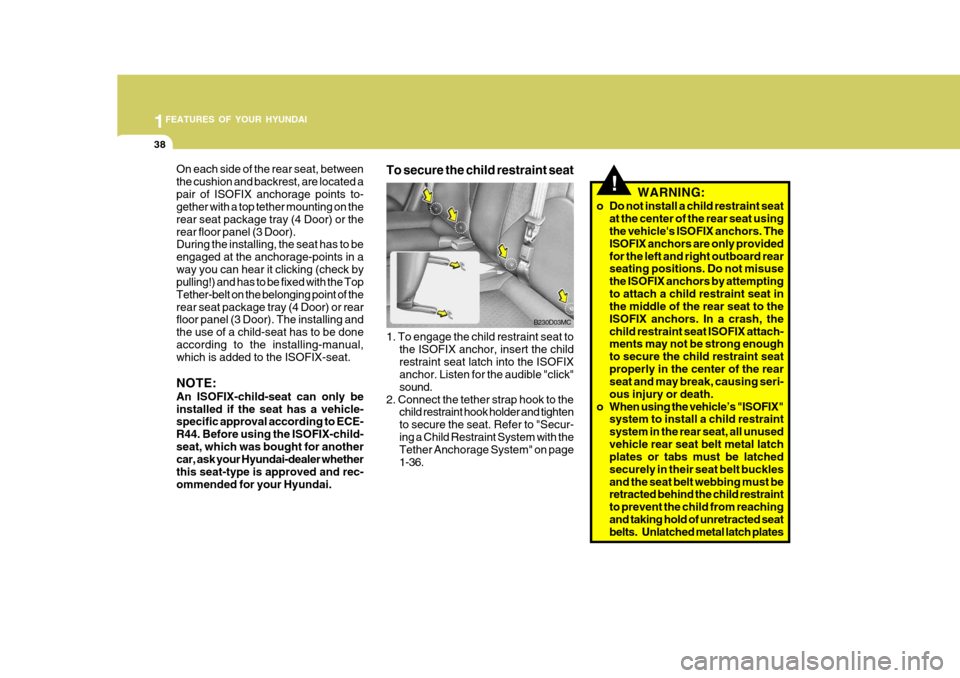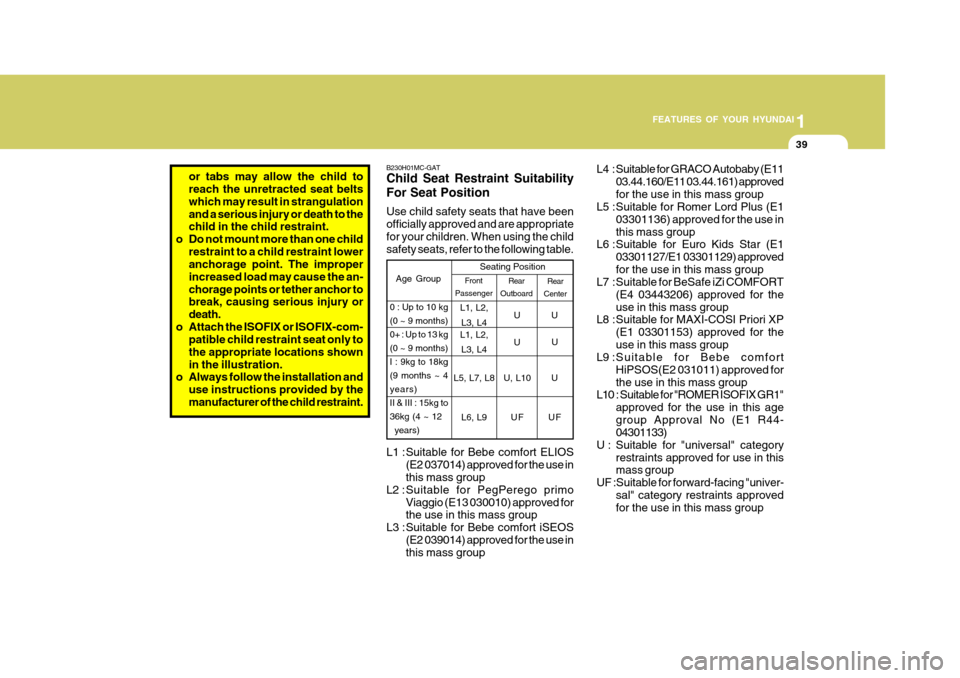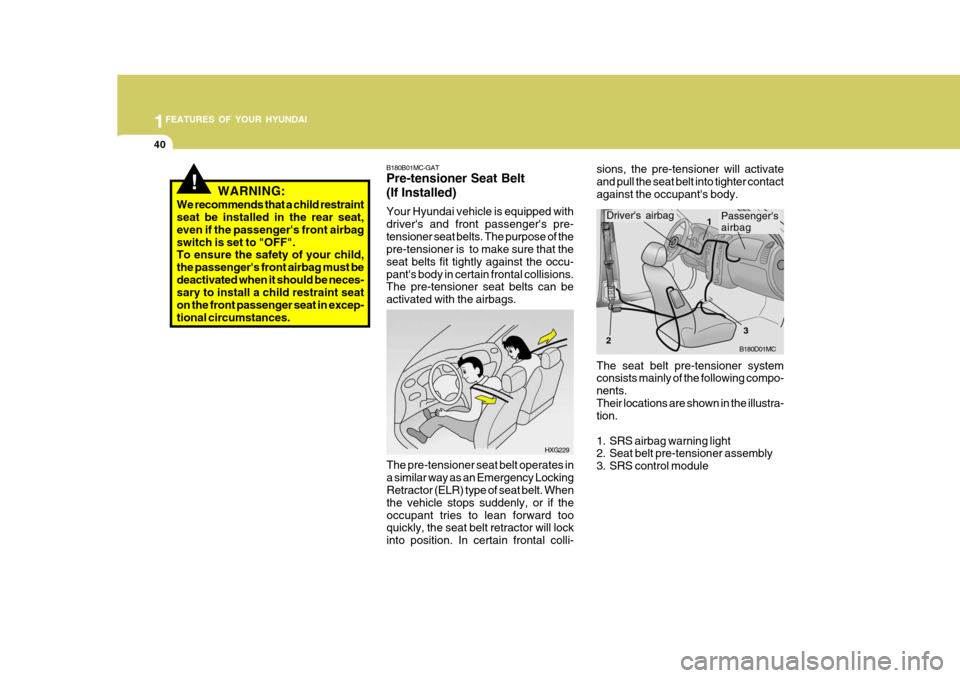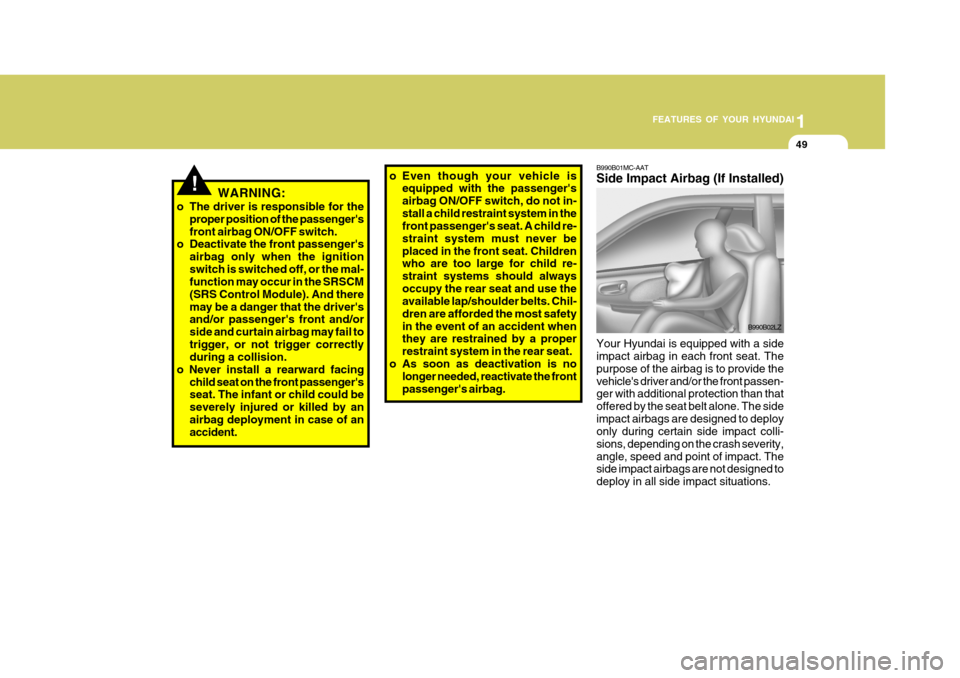2007 Hyundai Accent child seat
[x] Cancel search: child seatPage 48 of 282

1FEATURES OF YOUR HYUNDAI
36
B230E01MC-GAT Securing a Child Restraint Sys- tem with "Tether Anchorage" System (3 Door) Three child restraint hook holders are located on the rear floor panel.
2. Route the child restraint seat strapover the seatback. For vehicles with adjustable head- rests, route the tether strap under theheadrest and between the headrest posts, otherwise route the tether strap over the top of the seatback.
3. Connect the tether strap hook (2) to the child restraint hook holder (1) andtighten to secure the seat. B230C02MC
1. Open the tether anchor cover on therear floor panel.
B230E01MC
B230C03A-GAT Securing a Child Restraint Sys- tem with "Tether Anchorage"System (4 Door) Three child restraint hook holders are located on the rear seat package tray.
1. Open the tether anchor cover on the rear seat package tray.B230C01MC
Page 49 of 282

1
FEATURES OF YOUR HYUNDAI
37
B230C02MC
2. Route the child restraint seat strap over the seatback. For vehicles with adjustable head- rests, route the tether strap under theheadrest and between the headrest posts, otherwise route the tether strap over the top of the seatback.
3. Connect the tether strap hook (2) to the child restraint hook holder (1) and tighten to secure the seat.
B230D01MC-GAT Using a Child Restraint System with "ISOFIX" System and"Tether Anchorage" System ISOFIX is a standardised method of fitting child seats that eliminates the need to use the standard adult seat beltto secure the seat in the vehicle. This enables a much more secure and posi- tive location with the added benefit ofeasier and quicker installation. An ISOFIX-seat can only be installed if it has vehicle-specific approval in ac- cordance with the requirements of ECE- R44. For your Hyundai, the HyundaiISOFIX GR1 / Hyundai Duo / Römer ISOFIX GR1 and the Römer Duo ISOFIX
B230D01MC / Britax Duo ISOFIX is approved ac- cording to the requirement ECE-R44.This seat has been tested extensively by Hyundai and is recommended for your Hyundai. NOTE: At present, this seat is the only one complying with that provision. In case that other manufacturers willfurnish proof of a respective certifi- cation, Hyundai is going to evaluate this seat carefully and will give arecommendation provided that seat complies to the law. Please ask your Hyundai dealer in this respect.
B230D02MC
ISOFIX Anchor
ISOFIX Anchor Position Indicator
Page 50 of 282

1FEATURES OF YOUR HYUNDAI
38
WARNING:
o Do not install a child restraint seat at the center of the rear seat using the vehicle's ISOFIX anchors. The ISOFIX anchors are only providedfor the left and right outboard rear seating positions. Do not misuse the ISOFIX anchors by attemptingto attach a child restraint seat in the middle of the rear seat to the ISOFIX anchors. In a crash, thechild restraint seat ISOFIX attach- ments may not be strong enough to secure the child restraint seatproperly in the center of the rear seat and may break, causing seri- ous injury or death.
o When using the vehicle’s "ISOFIX" system to install a child restraintsystem in the rear seat, all unusedvehicle rear seat belt metal latch plates or tabs must be latched securely in their seat belt bucklesand the seat belt webbing must be retracted behind the child restraint to prevent the child from reachingand taking hold of unretracted seat
belts. Unlatched metal latch plates
B230D03MC
1. To engage the child restraint seat to the ISOFIX anchor, insert the child restraint seat latch into the ISOFIX anchor. Listen for the audible "click" sound.
2. Connect the tether strap hook to the child restraint hook holder and tightento secure the seat. Refer to "Secur-ing a Child Restraint System with the Tether Anchorage System" on page 1-36.
To secure the child restraint seat!
On each side of the rear seat, between the cushion and backrest, are located apair of ISOFIX anchorage points to- gether with a top tether mounting on the rear seat package tray (4 Door) or therear floor panel (3 Door). During the installing, the seat has to be engaged at the anchorage-points in away you can hear it clicking (check by pulling!) and has to be fixed with the Top Tether-belt on the belonging point of therear seat package tray (4 Door) or rear floor panel (3 Door). The installing and the use of a child-seat has to be doneaccording to the installing-manual, which is added to the ISOFIX-seat. NOTE: An ISOFIX-child-seat can only be installed if the seat has a vehicle- specific approval according to ECE- R44. Before using the ISOFIX-child-seat, which was bought for another car, ask your Hyundai-dealer whether this seat-type is approved and rec-ommended for your Hyundai.
Page 51 of 282

1
FEATURES OF YOUR HYUNDAI
39
or tabs may allow the child to reach the unretracted seat belts which may result in strangulationand a serious injury or death to the child in the child restraint.
o Do not mount more than one child
restraint to a child restraint loweranchorage point. The improper increased load may cause the an-chorage points or tether anchor to break, causing serious injury or death.
o Attach the ISOFIX or ISOFIX-com- patible child restraint seat only tothe appropriate locations shownin the illustration.
o Always follow the installation and
use instructions provided by themanufacturer of the child restraint.
L1 : Suitable for Bebe comfort ELIOS(E2 037014) approved for the use in this mass group
L2 :Suitable for PegPerego primo
Viaggio (E13 030010) approved forthe use in this mass group
L3 : Suitable for Bebe comfort iSEOS
(E2 039014) approved for the use inthis mass group
B230H01MC-GAT Child Seat Restraint Suitability For Seat Position Use child safety seats that have been officially approved and are appropriatefor your children. When using the child safety seats, refer to the following table.
Rear
Center
Age Group Seating Position
UU
L1, L2, L3, L4 U
U
Rear
Outboard
Front
Passenger
0 : Up to 10 kg (0 ~ 9 months)0+ : Up to 13 kg(0 ~ 9 months)I : 9kg to 18kg(9 months ~ 4years)II & III : 15kg to36kg (4 ~ 12 years) L1, L2,
L3, L4
L5, L7, L8 U, L10 U
L6, L9 U F U F
L4 : Suitable for GRACO Autobaby (E11 03.44.160/E11 03.44.161) approved for the use in this mass group
L5 :Suitable for Romer Lord Plus (E1
03301136) approved for the use inthis mass group
L6 :Suitable for Euro Kids Star (E1
03301127/E1 03301129) approvedfor the use in this mass group
L7 :Suitable for BeSafe iZi COMFORT
(E4 03443206) approved for theuse in this mass group
L8 :Suitable for MAXI-COSI Priori XP
(E1 03301153) approved for theuse in this mass group
L9 :Suitable for Bebe comfort
HiPSOS(E2 031011) approved forthe use in this mass group
L10 : Suitable for "ROMER ISOFIX GR1"
approved for the use in this agegroup Approval No (E1 R44- 04301133)
U : Suitable for "universal" category restraints approved for use in thismass group
UF :Suitable for forward-facing "univer- sal" category restraints approvedfor the use in this mass group
Page 52 of 282

1FEATURES OF YOUR HYUNDAI
40
The seat belt pre-tensioner system consists mainly of the following compo- nents.Their locations are shown in the illustra- tion.
1. SRS airbag warning light
2. Seat belt pre-tensioner assembly
3. SRS control module
Passenger's airbag
B180D01MC
Driver's airbag1
2 3
sions, the pre-tensioner will activate and pull the seat belt into tighter contactagainst the occupant's body.
HXG229
B180B01MC-GAT Pre-tensioner Seat Belt (If Installed) Your Hyundai vehicle is equipped with driver's and front passenger's pre-tensioner seat belts. The purpose of the pre-tensioner is to make sure that the seat belts fit tightly against the occu-pant's body in certain frontal collisions. The pre-tensioner seat belts can be activated with the airbags.
The pre-tensioner seat belt operates ina similar way as an Emergency Locking Retractor (ELR) type of seat belt. When the vehicle stops suddenly, or if theoccupant tries to lean forward too quickly, the seat belt retractor will lock into position. In certain frontal colli-
!WARNING:
We recommends that a child restraint seat be installed in the rear seat, even if the passenger's front airbagswitch is set to "OFF". To ensure the safety of your child, the passenger's front airbag must bedeactivated when it should be neces- sary to install a child restraint seat on the front passenger seat in excep-tional circumstances.
Page 57 of 282

1
FEATURES OF YOUR HYUNDAI
45
severely injured or killed by an airbag deployment in case of an accident.
o Do not allow children to ride in the
front passenger seat. If older chil-dren (teenagers and older) must ride in the front seat, make surethey are always properly belted and that the seat is moved back as far as possible.
o For maximum safety protection in all types of crashes, all occupantsincluding the driver should alwayswear their seat belts whether or not an airbag is also provided at their seating position to minimizethe risk of severe injury or death in the event of a crash. Do not sit or lean unnecessarily close to theairbag while the vehicle is in mo- tion.
o The SRS airbag system must de- ploy very rapidly to provide pro-tection in a crash. If an occupant is out of position because of notwearing a seat belt, the airbag may forcefully contact the occupant causing serious or fatal injuries. The SRS consists of the following com-ponents:
- Driver's Airbag Module
- Passenger's Front Airbag Module
- SRS Service Reminder Indicator (SRI)
- SRS Control Module (SRSCM)
The SRSCM continually monitors allelements while the ignition is "ON" todetermine if a frontal or near-frontal impact is severe enough to require airbag deployment. B240B01MC-GAT SRS Components and Functions
B240B01L
o The driver should sit back as far as
possible while still maintaining control of the vehicle. If you aresitting too close to the airbag, it can cause death or serious injury when it inflates.
o No objects should be placed over or near the airbag modules on thesteering wheel, instrument panel,and the front passenger's panel above the glove box, because any such object could cause harmif the vehicle is in a crash severe enough to cause the airbags to deploy.
o If the airbags deploy, they must be replaced by an authorized Hyundaidealer.
o Do not tamper with or disconnect SRS wiring, or other componentsof the SRS system. Doing socould result in injury, due to acci- dental firing of the airbags or by rendering the SRS inoperative.
o Do not install a child restraint sys- tem in the front passenger seatposition. A child restraint systemmust never be placed in the front seat. The infant or child could be
Page 59 of 282

1
FEATURES OF YOUR HYUNDAI
47
o The SRS can function only when
the ignition key is in the "ON" position. If the SRS is not working properly,(1) The SRS SRI does not come on
when the ignition key is turnedto the "ON" position or after the engine is started.
(2) The SRS SRI blinks for a sec- ond and remains on after illu-minating for about 6 secondswhen the ignition key is turned to the "ON" position or after he engine is started.
(3) The SRS SRI illuminates while driving.
If this occurs, have your vehicleimmediately inspected by your Hyundai dealer.
o Before you replace a fuse or dis- connect a battery terminal, turnthe ignition key to the "LOCK" position or remove the ignitionkey. Never remove or replace the air bag related fuse(s) when the ignition key is in the "ON" posi-tion. Failure to heed this warning will cause the SRS SRI to illumi- nate.
!WARNING:
o When the SRS is activated, there may be a loud noise and fine dust will be released throughout the vehicle. These conditions are nor- mal and are not hazardous. How-ever, the fine dust generated dur- ing airbag deployment may cause skin irritation. Wash your handsand face thoroughly with lukewarm water and a mild soap after an accident in which the airbags weredeployed.
Passenger's Front Airbag
B240B05LB990A01MC-GAT Passenger's Front Airbag ON/ OFF Switch (If Installed)
B990A01MC
The passenger's front airbag can be deactivated by the passenger's frontairbag ON/OFF switch (1) if a child restraint is installed on the front passenger's seat or if the frontpassenger's seat is unoccupied by a person. To ensure the safety of your child, thepassenger's front airbag must be deac- tivated when it should be necessary to install a rearward facing child seat onthe front passenger seat in exceptional circumstances. (1)
Page 61 of 282

1
FEATURES OF YOUR HYUNDAI
49
B990B01MC-AAT Side Impact Airbag (If Installed) Your Hyundai is equipped with a side impact airbag in each front seat. The purpose of the airbag is to provide thevehicle's driver and/or the front passen- ger with additional protection than that offered by the seat belt alone. The sideimpact airbags are designed to deploy only during certain side impact colli- sions, depending on the crash severity,angle, speed and point of impact. The side impact airbags are not designed to deploy in all side impact situations.
B990B02LZ
o Even though your vehicle is equipped with the passenger's airbag ON/OFF switch, do not in-stall a child restraint system in the front passenger's seat. A child re- straint system must never beplaced in the front seat. Children who are too large for child re- straint systems should alwaysoccupy the rear seat and use the available lap/shoulder belts. Chil- dren are afforded the most safetyin the event of an accident when they are restrained by a proper restraint system in the rear seat.
o As soon as deactivation is no longer needed, reactivate the frontpassenger's airbag.!WARNING:
o The driver is responsible for the proper position of the passenger's front airbag ON/OFF switch.
o Deactivate the front passenger's
airbag only when the ignitionswitch is switched off, or the mal- function may occur in the SRSCM (SRS Control Module). And theremay be a danger that the driver's and/or passenger's front and/or side and curtain airbag may fail totrigger, or not trigger correctly during a collision.
o Never install a rearward facing
child seat on the front passenger'sseat. The infant or child could be severely injured or killed by anairbag deployment in case of an accident.